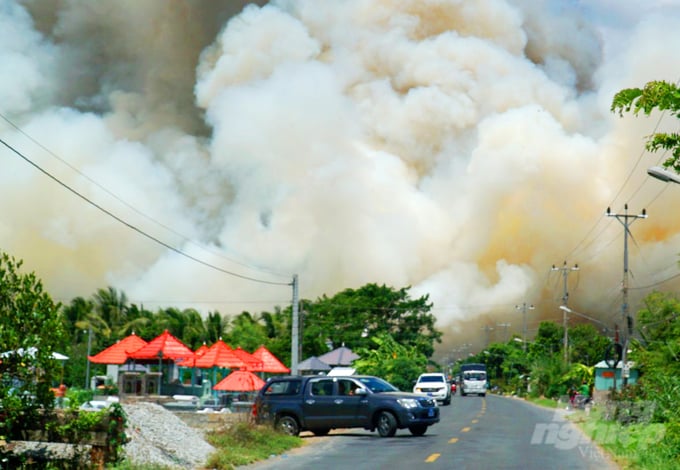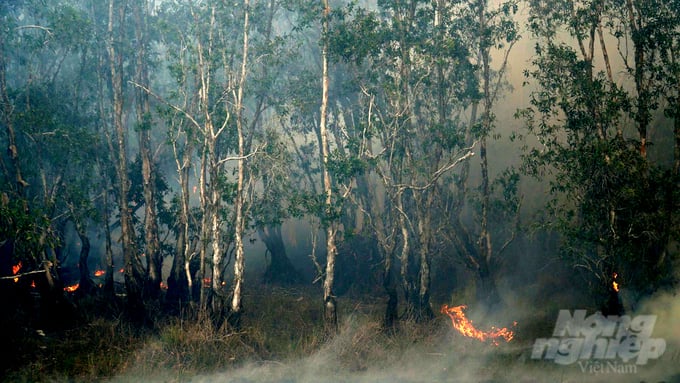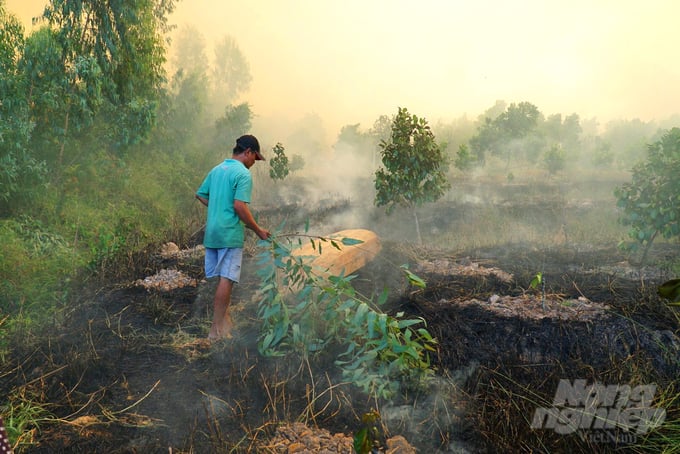December 18, 2025 | 12:16 GMT +7
December 18, 2025 | 12:16 GMT +7
Hotline: 0913.378.918
December 18, 2025 | 12:16 GMT +7
Hotline: 0913.378.918

The forest fire originated in the wetland habitat reserve area, which is home to rare bird species, located in sub-zone A1 of Tram Chim National Park, approximately 300 meters from Provincial Road 843. Photo: Le Hoang Vu.
According to initial reports, the forest fire originated in the wetland habitat reserve area, which is home to rare bird species, located in sub-zone A1 of Tram Chim National Park, approximately 300 meters from Provincial Road 843.
When the fire broke out in the A1 forest area, it created a dense smoke plume measuring several hundreds of meters in height. The smoke obscured visibility for approximately 1 kilometer on the Provincial Road 843. This road, a critical transportation route connecting Tam Nong, Tan Hong, and Hong Ngu districts to Hong Ngu city and Vietnam's border with Cambodia, experienced localized traffic congestion as a result.
As vehicles traveled through this stretch, the smoke and ash significantly reduced visibility, forcing their drivers to stop or decelerate.

Local authorities are currently focused on extinguishing the fire; and preventing the fire from spreading to the remaining Melaleuca forest area. Photo: Le Hoang Vu.
Le Thanh Son, Team Leader of the Resource Management Team under the Forest Protection Force at Tram Chim National Park, stated that various local agencies, the military, and the forest fire prevention force under the Dong Thap province's Sub-Department of Forest Protection have mobilized over 200 people to extinguish the fire in sub-zone A1.
Accordingly, the firefighting force has employed water to contain the fire, with a focus on establishing firebreaks and preventing the fire from spreading to the remaining Melaleuca forest area within the park. Local authorities have also formulated various contingency plans, including the potential evacuation of residents, especially children, from the affected area.
“The fire has spread rapidly due to the sunny midday weather and strong winds. However, local authorities are currently unable to gauge the extent of the damage and the total affected forest area,” reported Team Leader Le Thanh Son.

The forest fire at Tram Chim National Park has caused extensive damage to the surrounding fruit orchards owned by local residents. Photo: Le Hoang Vu.
Tram Chim National Park spans an area of over 7,300 hectares in Tam Nong district, Dong Thap province. After being designated as a national park in 1998, Tram Chim National Park served as a habitat for over 130 species of high-level flora, 231 species of waterfowl, over 100 species of fauna, and over 150 species of fish.
The park also plays a crucial role in conserving the critically endangered Sarus crane species. As a result of the declining Sarus crane population in Tram Chim National Park in recent years, Dong Thap province approved a conservation and development project for the Sarus crane at Tram Chim National Park for the years between 2022 and 2032. The project received an estimated total budget of 185 billion Vietnamese Dong.
According to researchers, the saurus crane is a rare and endangered species listed in both the Vietnamese and global red books. These birds are characterized by their red-headed and feathered necks, with gray patterns on their wings and tails. An adult crane stands between 1.5 and 1.8 meters tall, with a wingspan between 2.2 and 2.5 meters, and a weight between 8 and 10 kilograms. Cranes typically mate at three years old. Subsequently, they breed and nurture their offspring for a year before laying the next clutch.
Cranes often choose Tram Chim as their migration destination in Vietnam towards the end of the year and the beginning of the following year. The highest number of cranes recorded at the National Park was roughly 1,000 individuals. However, this figure has gradually declined over the years. According to statistics from Tram Chim National Park, only 21 cranes returned in 2015, followed by 14 in 2016, 9 in 2017, 11 in 2018, and 11 in 2019. Reportedly, no cranes returned in 2020, and only 3 returned in 2021 before disappearing for two more years.
The reason for this scarcity has been attributed to changes in the ecological environment within the park. Reduced flooding prevents the washing away of the surface vegetation, thereby reducing the local fish population, a primary food source for the cranes.
Translated by Nguyen Hai Long

(VAN) Patrol Team No. 15 has been executing patrol, inspection, and control duties in the Southwest waters, a region identified as having a high risk of violations.

(VAN) UNICEF, IOM, and the U.S. Department of State have worked together to ensure the justice system becomes a protective shield for children and other vulnerable groups.

(VAN) As a key driving force of green transition, the circular economy is being identified as a strategic pillar of Viet Nam's new growth model.

(VAN) UNICEF and IOM receive this aid and provide essential services to assist families affected by recent storms and floods.

(VAN) Circular economy is regarded as a suitable pathway for Viet Nam’s fisheries sector, helping to improve production efficiency, optimize resources, and reduce environmental pressure.

(VAN) Vietnam and the UK are promoting cooperation in agriculture, environment, renewable energy, and green transition, with the goal of achieving Net Zero.

(VAN) Switzerland highly values carbon credit cooperation potential with Viet Nam and hopes to begin negotiations under Article 6 of the Paris Agreement.